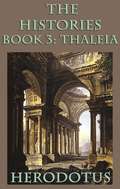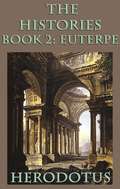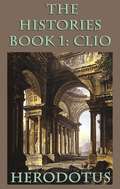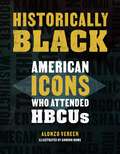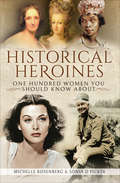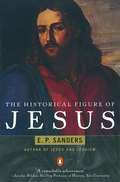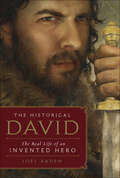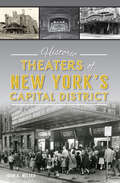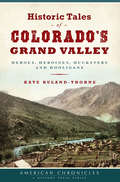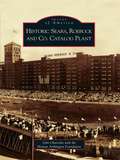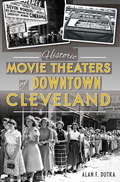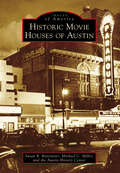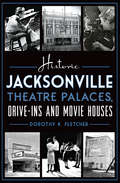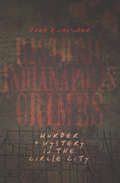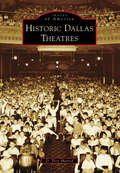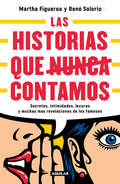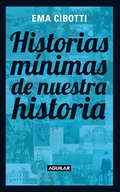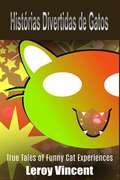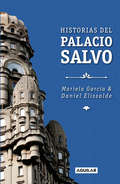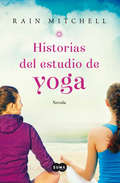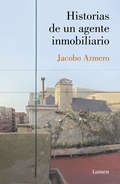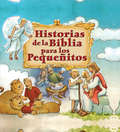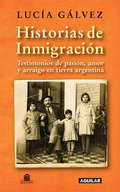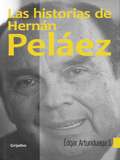- Table View
- List View
The Histories Book 3: Thaleia
by HerodotusHerodotus was an ancient Greek historian who lived in the fifth century BC (c.484 - 425 BC). He has been called the "Father of History", and was the first historian known to collect his materials systematically, test their accuracy to a certain extent and arrange them in a well-constructed and vivid narrative. The Histories-his masterpiece and the only work he is known to have produced-is a record of his "inquiry", being an investigation of the origins of the Greco-Persian Wars and including a wealth of geographical and ethnographical information. The Histories, were divided into nine books, named after the nine Muses: the "Muse of History", Clio, representing the first book, then Euterpe, Thaleia, Melpomene, Terpsichore, Erato, Polymnia, Ourania and Calliope for books 2 to 9, respectively.
The Histories Book 2: Euterpe
by HerodotusHerodotus was an ancient Greek historian who lived in the fifth century BC (c.484 - 425 BC). He has been called the "Father of History", and was the first historian known to collect his materials systematically, test their accuracy to a certain extent and arrange them in a well-constructed and vivid narrative. The Histories-his masterpiece and the only work he is known to have produced-is a record of his "inquiry", being an investigation of the origins of the Greco-Persian Wars and including a wealth of geographical and ethnographical information. The Histories, were divided into nine books, named after the nine Muses: the "Muse of History", Clio, representing the first book, then Euterpe, Thaleia, Melpomene, Terpsichore, Erato, Polymnia, Ourania and Calliope for books 2 to 9, respectively.
The Histories Book 1: Clio
by HerodotusHerodotus was an ancient Greek historian who lived in the fifth century BC (c.484 - 425 BC). He has been called the "Father of History", and was the first historian known to collect his materials systematically, test their accuracy to a certain extent and arrange them in a well-constructed and vivid narrative. The Histories-his masterpiece and the only work he is known to have produced-is a record of his "inquiry", being an investigation of the origins of the Greco-Persian Wars and including a wealth of geographical and ethnographical information. The Histories, were divided into nine books, named after the nine Muses: the "Muse of History", Clio, representing the first book, then Euterpe, Thaleia, Melpomene, Terpsichore, Erato, Polymnia, Ourania and Calliope for books 2 to 9, respectively.
Historically Black: American Icons Who Attended HBCUs
by Alonzo VereenA vibrant collection of biographies and illustrated portraits that capture the brilliance of more than thirty American icons, Historically Black is a celebration of Black excellence in fields ranging from politics to STEM, sports to pop culture, and more.From the moment the first HBCU was founded in 1837, Black Americans from all walks of life have created collegiate experiences that enrich and transcend mainstream postsecondary education. Today, more than 100 colleges and universities are registered under the HBCU banner and over 200,000 students are enrolled. With a legacy of marching bands, drill teams, choral ensembles, homecoming, and more, attending an HBCU is an emblem of pride and a source of joy. Historically Black documents not only HBCU cultural traditions but also the remarkable stories of former students. HBCU attendees in the book include: Booker T. Washington, James Weldon Johnson, Ida B. Wells-Barnett, W.E.B. Du Bois, Mary McLeod Bethune, Alice Dunbar Nelson, Zora Neale Hurston, Howard Thurman, Langston Hughes, Thurgood Marshall, Bayard Rustin, Dorothy Vaughan, Katherine Johnson, Mary Jackson, Leontyne Price, Martin Luther King, Jr., Toni Morrison, John Lewis, Bob Hayes, Oprah Winfrey, Kamala Harris, Hakeem M. Oluseyi, Taraji P. Henson, Erykah Badu, Stacey Abrams, Ta-Nehisi Coates, Chadwick Boseman, Hebru Brantley, Ibram X. Kendi, J.R. Smith, Megan Thee Stallion, and Mo&’ne Davis.
Historical Heroines: One Hundred Women You Should Know About
by Sonia D Picker Michelle RosenbergFrom Mata Hari and Pocahontas to Lucrezia Borgia and Hedy Lamarr—fascinating portraits of history’s most unforgettable, and some unjustly forgotten, women. Cleopatra. Audrey Hepburn. Sappho. Calamity Jane. Marie Antoinette. Lilith. Harriet Beecher Stowe. Dame Emma Hamilton. Mary Shelley. Mary Frith. Some are celebrated in folklore legend; some are remembered only as movie stars; many will be familiar in their native countries; while others are, for the most part, unjustly unknown. Not anymore. Let this rewarding anthology set the record straight on: World War I heroine and nurse Edith Cavell; turn of the century Iñupiat explorer Ada Blackjack; eighteenth-century abolitionist, slave, and women’s rights pioneer Soujourner Truth; Gorgo, 480 BC Queen of Sparta; Agent 355, the American Revolution’s most mysterious spy; nineteenth-century socialite and archaeologist Lady Hester Stanhope; eighteenth-century Irish physician Margaret Bulky who plied her trade by passing as a man for fifty years; and many, many more adventurers, leaders, and freedom fighters—each and every one, a groundbreaker whose name deserves a place in history.
The Historical Figure Of Jesus
by E. P. Sanders E. SandersA biography of the historical figure of Jesus. The book studies the relationship between Judaism and Christianity, distinguishing the certain from the improbable, and assessing the historical and religious context of Christ's time. The spread of Christianity is also discussed.
The Historical David: The Real Life of an Invented Hero
by Joel BadenJoel Baden, a leading expert on the Old Testament, offers a controversial look at the history of King David, the founder of the nation of Israel whose bloodline leads to Jesus, challenging prevailing popular beliefs about his legend in The Historical David.Baden makes clear that the biblical account of David is an attempt to shape the events of his life politically and theologically. Going beyond the biblical bias, he explores the events that lie behind the David story, events that are grounded in the context of the ancient Near East and continue to inform modern Israel.The Historical David exposes an ambitious, ruthless, flesh-and-blood man who achieved power by any means necessary, including murder, theft, bribery, sex, deceit, and treason. As Baden makes clear, the historical David stands in opposition not only to the virtuous and heroic legends, but to our very own self-definition as David’s national and religious descendants.Provocative and enlightening, The Historical David provides the lost truth about David and poses a challenge to us: how do we come to terms with the reality of a celebrated hero who was, in fact, similar to the ambitious power-players of his day?
Historic Theaters of New York's Capital District (Landmarks)
by John A. MillerFor generations, residents of New York's Capital District have flocked to the region's numerous theaters. The history behind the venues is often more compelling than the shows presented in them. John Wilkes Booth brushed with death on stage while he and Abraham Lincoln were visiting Albany. The first exhibition of broadcast television was shown at Proctor's Theater in Schenectady, although the invention ironically contributed to the downfall of theaters across the nation. A fired manager of the Green Street Theatre seized control of the theater with a group of armed men, but Albany police stormed the building and the former manager regained control. Author John A. Miller charts the entertaining history.
Historic Tales of Colorado’s Grand Valley: Heroes, Heroines, Hucksters and Hooligans (American Chronicles)
by Kate Ruland-ThorneColorado's Grand Valley has an extensive geological and human history going back millennia. Franciscan priests worked in tandem with the native Ute people to plot passage through the territory, opening the valley to unprecedented settlement. The region became the playground of enterprising visionaries, murderous outlaws, hooligans and harlots alike. From the gruesome Meeker massacre and its tragic consequences for the Ute nation to the mysterious murder of Sam McMullin and a showdown with the Ku Klux Klan in 1925, uncover the engrossing stories of an unyielding land. Author Kate Ruland-Thorne recounts many of the defining and damning moments throughout Grand Valley history.
Historic Sears, Roebuck and Co. Catalog Plant
by John Oharenko Homan Arthington FoundationLocated on the site of the original Sears Tower, the historic Sears, Roebuck and Company catalog plant is one of the nation's most unique landmarks. Representing American ingenuity at its best, Richard Sears and Julius Rosenwald combined technology, commerce, and social science with bricks and mortar to build "the World's Largest Store" on Chicago's West Side. Completed in 1906, the plant housed nearly every conceivable product of the time: clothing, jewelry, furniture, appliances, tools, and more. The complex employed 20,000 people, and merchandise orders were processed and delivered by rail--within the same day. During the first two decades of the 20th century, almost half of America's families shopped the over 300 million catalogs published in that era. WLS (World's Largest Store) Radio broadcasted the Gene Autrey show from the top of the tower, and the first Sears retail store opened here on Homan Avenue and Arthington Street. In 1974, Sears moved to the current Sears Tower. Thanks to many individuals who fought to save these architecturally and historically important treasures, the administration building, the original Sears Tower, the catalog press-laboratory building, and the powerhouse remain today. There are currently plans for redeveloping these buildings into housing, office, and retail space. A new Homan Square Community Center stands on the site of the merchandise building.
Historic Movie Theaters of Downtown Cleveland (Landmarks)
by Alan F. DutkaThe first movie theaters in Cleveland consisted of converted storefronts with sawed-off telephone poles substituting for chairs and bedsheets acting as screens. In 1905, Clevelanders marveled at moving images at Rafferty's Monkey House while dodging real monkeys and raccoons that wandered freely through the bar. By the early 1920s, a collection of marvelous movie palaces like the Stillman Theater lined Euclid Avenue, but they survived for just two generations. Clevelanders united to save the State, Ohio and Allen Theaters, among others, as wrecking balls converged for demolition. Those that remain compose one of the nation's largest performing arts centers. Alan F. Dutka shares the remarkable histories of Cleveland's downtown movie theaters and their reemergence as community landmarks.
Historic Movie Houses of Austin (Images of America)
by Austin History Center Michael C. Miller Susan RittereiserMotion pictures came to Austin on October 10, 1896, debuting at the Hancock Opera House. Since then, movies have continued to enchant, entertain, and inform the citizens of the capital of Texas. And, the places--the movie houses and theaters--where people saw motion pictures played just as important a role in the moviegoing experience as the movies themselves. As the city's population grew and motion picture technology changed, so too did Austin's movie houses, from the first kinetoscope parlor on Congress Avenue to the city' s first four-plex, the Aquarius 4, in southeast Austin. While most of these places are long gone, some withstood the test of time and are still showing movies or have been repurposed for other uses. Through the rich archival collections of the Austin History Center, Historic Movie Houses of Austin explores the stories of these important historic spaces and of the lives of those who were connected with them.
Historic Jacksonville Theatre Palaces, Drive-ins and Movie Houses (Landmarks)
by Dorothy K. FletcherJacksonville's theatre and performance history is rich with flair and drama. The theatres, drive-ins and movie houses that brought entertainment to its citizens have their own exciting stories. Some have passed into memory. The Dixie Theatre, originally part of Dixieland Park, began to fade in 1909. The Palace Theatre, home to vaudeville acts, was torn down in the '50s. The Alhambra has been everyone's favorite dinner theatre since 1967's debut of Come Blow Your Horn. Local author Dorothy K. Fletcher revives the history of Jacksonville's theatres. Lights, camera, action!
Historic Indianapolis Crimes: Murder & Mystery in the Circle City (Murder And Mayhem Ser.)
by Fred D. CavinderFrom the 1954 &“Dresser Drawer Murder&” to the mass killing of seven people in 2006, the author of Forgotten Hoosiers chronicles Indianapolis&’s dark history. Hear tales from the Circle City&’s murderous underbelly, from poor Silvia Likens, who was tortured for months by her foster mother and eventually discovered dead, to Carrie Selvage, whose skeleton was found in an attic twenty years after she disappeared from a hospital bed in 1900. Discover how housekeepers found Dorothy Poore stuffed in a dresser drawer on a July day in 1954 and the curious story of Marjorie Jackson, her body was discovered clothed in pajama bottoms and a flannel robe on her kitchen floor, and police found $5 million hidden around her house in garbage cans, drawers, closets, toolboxes and a vacuum cleaner bag. Join local historian Fred Cavinder as he recounts the gruesome tales of Indiana&’s capital city, from mystery to murder. Includes photos!
Historic Dallas Theatres
by D. Troy SherrodDallas was the show business capital of Texas and much of the South throughout the 20th century. More than 100 theatres served the city's neighborhoods, and Elm Street once boasted more than 15 vaudeville and movie theatres--second in number to Broadway. The quality of the show houses in Dallas were surpassed by few cities and all major, and most minor, Hollywood studios maintained Dallas offices. Notable names figuring in this history include Margo Jones, "Blind" Lemon Jefferson, Karl Hoblitzelle, Baruch Lumet, Bob Hope, Greer Garson, Linda Darnell, Howard Hughes, Clyde Barrow, Gene Autry, Oliver Stone, Pappy Dolson, Jack Ruby, Lee Harvey Oswald, Nicola Rescigno, Don Henley, and Frank Lloyd Wright.
Las historias que nunca contamos: Secretos, intimidades, locuras y muchas más revelaciones de los famosos
by Martha FigueroaLas historias que nunca contamos reúne los secretos más jugosos de dos entregados y exitosos periodistas de espectáculos. El libro está lleno de revelaciones, ironía y reflexiones divertidas de un par de reporteros que "sabían demasiado". Una pelea con Adela Micha ante la mirada aterrada de un actor sin pelo; las escapadas nocturnas de Luis Miguel; una visita a la cárcel; un misterio candente de Alejandro Sanz; ¿qué esconden las piernas de Julio Iglesias?; el día que Thalía se vistió de luto ¡y terminó en una boda!; el miedo de Jenni Rivera o la verdadera tristeza de José José. ¿Creías que era todo? ¡No! En Las historias que nunca contamos se describe, además, la furia de un bondadoso Premio Nobel; lo fácil que fue burlar la seguridad de la mansión de Kate del Castillo; las locuras de Belinda y los viajes en la cajuela de Gloria Trevi. Con profundo conocimiento de la industria del entretenimiento, Martha Figueroa y René Solorio, comparten anécdotas y notas que nunca les dejaron publicar, porque no era el momento, porque los jefes lo prohibieron, por miedo, ¡porque serían un escándalo!, o porque eran tan extraordinarias que nadie las creía. ¡Y aquí es donde el lector corre a comprar el libro -pues conoce el trabajo del show business- y valora la seriedad de los autores!
Historias mínimas de nuestra historia
by Ema CibottiLa historiadora Ema Cibotti rescata del olvido pequeñas historias que revelan una espesa trama de hechos menudos, muchas veces obviados que sin embargo son constitutivos de nuestro pasado. Nuestra nación puede compararse con un edificio en perpetua construcción. A lo largo de la historia se han ido levantando los cimientos, las columnas y las vigas, y su fachada suele variar de color según quién se haga cargo del relato. Pero para descubrir los ladrillos y el cemento que le dan significado y lo hacen habitable, esos relatos no son suficientes: es necesario acercarse, palpar los ladrillos y hurgar debajo de las muchas capas de pintura que los cubren. La historiadora Ema Cibotti agregó a sus conocimientos la búsqueda en cartas y memorias, en documentos oficiales y particulares, y con eso urdió estas pequeñas historias que revelan una espesa trama de hechos menudos, muchas veces obviados o directamente a punto de perderse en el olvido, que sin embargo son constitutivos de nuestro pasado, como lo son de ese edificio los ladrillos y el cemento. Los redactores de la Constitución en una tórrida aldea llamada Santa Fe; la declaración de amor de Carmen, la esposa del cacique Railef; más de sesenta ediciones de Anagnosia, el libro para aprender a leer que se vendía en el almacén; la verdadera revolución que avanzaba detrás de una zanja casi interminable; 459 diarios sostenidos por el ansia de información; tres seudónimos para una original operación literaria; la excluida población negra; mujeres maestras, mujeres periodistas, mujeres poetas, mujeres bandoneonistas; los protagonistas de un cuadro trágico; puchero, pizza y milanesas; un dandy en las filas de la democracia, son algunas de las historias que componen esta obra y que consolidan el edificio que seguimos construyendo. La crítica ha dicho... «La historiadora Ema Cibotti, sin demagogias discursivas ni afán de derribar próceres para ganarse a los detractores del sistema escolar, renueva la visión de la historia alumbrando rincones deliciosos y polémicos del escenario nacional.» Silvia Hopenhayn, La Nación
Histórias Divertidas de Gatos: Histórias e Experiências com Gatos Engraçados
by Leroy Vincent Gustavo PradoHistórias Divertidas de Gatos é um livro repleto de histórias e experiências divertidas e embaraçosas de pessoas com seus gatos. Este livro é ótimo para quem procura rir ou lembrar do seu gato favorito. Você vai se divertir e poderá até dizer: "Isso aconteceu comigo".
Historias del Palacio Salvo
by Daniel Elissalde Mariela GarcíaEn este libro, a través de sus investigaciones y de su pasión, los autores nos invitan a recorrerlo para descubrir su historia y las historias que, en sus entrañas, se tejieron a lo largo del tiempo. El Palacio Salvo es una silueta que identifica a Montevideo, un símbolo de hormigón y hueso. Es Historia y presente. En él hay memorias y misterios, pasillos silenciados, pinturas escondidas en sus entrepisos, acordes de La cumparsita, ecos de grandes bailes en sus soberbios salones, historias latentes en sus recovecos, arquitectura simbólica, arte y, también, vida cotidiana de los habitantes pasados y presentes. Lo vemos a diario, pero no hay mirada que pueda abarcar todo lo que muestra o sugiere.
Historias del estudio de yoga
by Rain MitchellUna historia de historias, de disyuntivas y de elecciones con el yoga como elemento de unión. Lee es un talentoso maestro de yoga y dueño del estudio de yoga Los Angeles Edendale. Sus estudiantes, que son de lo más superficiales y chic, como todo en Los Ángeles, han buscado a Lee para sanar su dolor físico y emocional. Lee alivia cada una de sus vidas a través de sus conocimientos llegando a mantener con ellas una singular amistad. Sin embargo, cuando una cadena de estudios de yoga en expansión en Los Ángeles intenta atraer a Lee con un contrato lucrativo y empieza a tener problemas maritales con su guapo marido, Alan, será el maestro el que necesite los consejos de sus alumnas más que nunca. Historias del estudio de yoga nos da una visión íntima sobre la tendencia actual de la práctica del yoga, contada con la dosis justa de humor, ingenio y sensibilidad para encantar a los lectores. Reseñas:«Divertido e inteligente... Tanto si eres un maestro de yoga como si eres un eterno iniciado (como yo) vas a adorar Historias del estudio de yoga».Anita Diamant, autora de The red tent. «Los pantalones de yoga son opcionales para esta historia que gira en torno al maestro yogui Lee y cuatro de sus dedicadas estudiantes: Stephanie, guionista de Hollywood, la bailarina Graciela, la exdrogadicta Katherine y la actriz Imani. Cada una de ellas con su carrera personal y su melodrama romántico, pero no hay que temer: el yoga los mantendrá unidos (...) Si te gustan las historias de amistad, unión y te gusta la postura de El perro mirando hacia abajo, este debería ser un agradable pasatiempo».Publisher Weekly «La perfecta integración de nombres y la explicación de las posiciones de yoga no es un obstáculo para una lectura fluida, a la vez que Mitchell avanza paulatinamente en el desarrollo de los personajes enriqueciendo esta divertida meditación sobre la construcción y el sostén de una comunidad».Booklist «Mitchell lleva al lector a un viaje exclusivo al interior de un estudio de yoga, no solo por la respiración y los movimientos, sino a través de todos los pequeños secretos que hay bajo las poses. Lo hace con humor, amor, angustia y situaciones identificables. Mitchell atrae al lector y lo envuelve en una historia de autodescubrimiento del amor, la amistad y el sentido común en un lugar poco común, pero con resultados que se identifican con la mayoría de nosotros».Romantic times book review
Historias de un agente inmobiliario
by Jacobo ArmeroUNA NOVELA PARA ENTRAR A VIVIR «Un estilo de la felicidad probablemente innato.»Enrique Vila-Matas Jacobo Armero bien podía haber sido notario, siguiendo la tradición familiar. Pero se dedicó a la arquitectura, y acabó convirtiéndose en experto y premiado agente inmobiliario, además de miembro de un club de mujeres lectoras. Vender casas es un oficio difícil, un arte que requiere grandes dotes de psicología y empatía, y que ofrece una oportunidad única para adentrarse en las vidas, mentes y almas de las personas. Armero cuenta con ese talento, una incondicional adoración por el género femenino, una buena red de contactos y un afán por dominar el posicionamiento geográfico que le permite no solo alcanzar el éxito comercial, sino también descubrir los secretos de los mejores edificios, calles, bares y restaurantes de la ciudad. Autoficción, guía secreta de Madrid y manual de instrucciones para vender o comprar una vivienda, Historias de un agente inmobiliario es un libro tan original como apasionante: la crónica de la salida de la crisis de un hombre que ha hecho de la imprevisibilidad un modo de vida, afrontando los desafíos cotidianos gracias a un inagotable sentido del humor, algunos libros iluminadores y el sabio ejemplo de quienes lo rodean. La crítica ha dicho...«Una novela sobre la burbuja inmobiliaria, sobre las hipotecas, sobre los pisos, sobre los sueños, contada con humor y con mucha vida.»Manuel Vilas «Un estilo de la felicidad probablemente innato. O las alegrías del agente Armero, con su drama de fondo. Comedia y tragedia. O de cómo "la crisis" desarboló nuestras industrias culturales, pero el narrador sobrevivió gracias a su inteligencia para saber beneficiar a los otros y de paso a sí mismo.»Enrique Vila-Matas «Una gran novela sobre la crisis. Sin dramatismo ni amargura, con mucho humor y una mezcla de cercanía y ternura, Jacobo Armero realiza una radiografía de la sociedad española de los últimos años a través de su propia historia personal: un arquitecto que se ve obligado a reconvertirse en agente inmobiliario. Desde un cierto neorrealismo lleno de color, Armero ha construido un libro que difícilmente se olvidará.»Guillermo Altares «Después de leer este libro no volverá a mirar a un agente inmobiliario de la misma manera. Una luminosa declaración de amor a Madrid y sus gentes.»Nuria Barrios
Historias de la Biblia para los Pequenitos
by Apryl Stott Genny MonchampVeinte historias de la Biblia presentan a los pequeñitos de 1-4 años la Palabra de Dios en formato atractivo. Cada historia está acompañada por elementos interactivos que permiten a los niños participar en su experiencia de lectura, fomentan comprensión, y estimulan y refuerzan habilidades cognitivas básicas.
Historias de Inmigración
by Lucía GálvezTestimonios de pasión, amor y arraigo en tierra argentina. Un mosaico de heroísmos y epopeyas cotidianas que bien puede simbolizar otros miles de historias desconocidas, como, quizá, la de nuestros propios abuelos. Entre las últimas décadas del siglo XIX y las primeras del XX, más de seis millones de personas llegaron a la Argentina. Muchas probaron fortuna y regresaron pronto a su tierra, pero más de la mitad decidió afincarse y echar raíces en el país: son la materia prima que conformó una parte importante de nuestra identidad. En sus valijas trajeron la añoranza de afectos dejados atrás, la tristeza de no saber si volverían alguna vez a su tierra, la incertidumbre ante lo desconocido y una enorme carga de esperanzas y expectativas. Suizos, saboyanos, piamonteses, italianos, franceses, alemanes del Volga, galeses, escoceses, vascos, gallegos, irlandeses, polacos# el trabajo de todos ellos está en nuestros campos y nuestras ciudades, su esfuerzo hizo crecer el país que sería la tierra de sus descendientes. Lucía Gálvez reunió estas historias de vida, narradas con orgullo por los propios protagonistas, sus hijos o sus nietos.
Las historias de Hernán Peláez
by Édgar ArtunduagaPeriodista deportivo y director del programa radial más escuchado en elpaís, Hernán Peláez se ha convertido en una de las voces más queridas enel país. Su amigo y por muchos años compañero radial, Édgar Artunduaga,hace la más completa biografía no solo del periodista sino del serhumano. Dignidad y entereza son las palabras que mejor definen a una personacomo Hernán Peláez Restrepo. Y es que en los casi cincuenta años que leha dedicado a su profesión de periodista, eso justamente ha demostradoser el doctor Peláez, como lo llaman sus compañeros de trabajo y suscolegas, un hombre digno e íntegro. Y, quizá por eso (bueno, habría quesumar también una tenacidad a toda prueba y dosis sobrehumanas decumplimiento), se ha convertido en una leyenda de los medios decomunicación, querido y respetado como pocos.El periodista Édgar Artunduaga -echando mano de la prodigiosa memoriadel protagonista de estas páginas, tanto como de sus propios recuerdos einvestigaciones, así como de varios testimonios de amigos y colegas- haconseguido reunir una fantástica colección de historias, anécdotas,experiencias y recuerdos de la vida y los trabajos de Hernán PeláezRestrepo.En palabras de Juan Gossaín, [...] Después de tanto tiempo dedicado sindescanso ni pausa a esa actividad [el periodismo], generalmentesalpicada de desencantos, Peláez puede mirar hacia atrás y sentir en elalma la tranquilizadora sensación del deber cumplido y del trabajo bienhecho. Desde el más humilde de los colombianos hasta el periodista másencopetado sienten por el doctor Peláez un afecto personal y una enormeconsideración profesional. Hernán es ya un miembro de nuestra familia.
